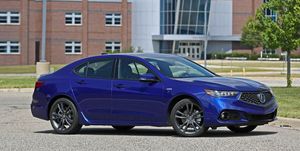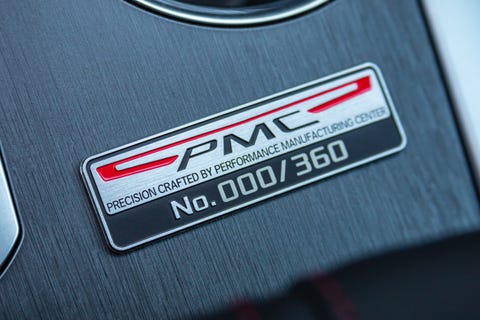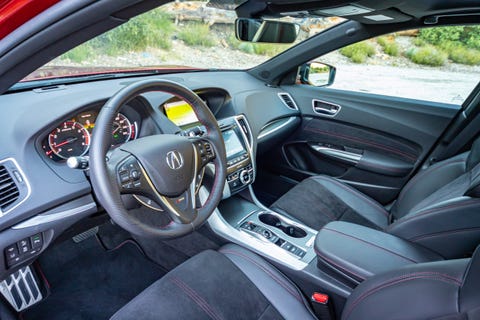The hue of the Valencia Red Pearl paint on the 2020 Acura TLX PMC Edition bends light across the car’s body with stunning effect. Taking five days to apply and cure in the same high-tech clean room of a factory that the brand uses to assemble its NSX supercar, the lustrous, metallic-red finish looks deep enough to dive into as it sparkles in the sun. While the rest of this final version of Acura’s current-generation TLX is less exciting than the vibrant paint that covers it, the PMC Edition does portend a more compelling future for Acura’s entry-luxury sedan.
The TLX’s PMC Edition, which references the Performance Manufacturing Center in Marysville, Ohio, where Acura builds it, is more curious than it is special. Beneath its stunning “nano-pigment” enamel, the PMC’s headline feature is that it is assembled by the same workers that put together the mid-engined NSX. That’s a neat sendoff before the redesigned 2021 TLX arrives later this year, albeit one that feels no less ordinary for the extra personal attention given to it. Along with the heretofore-NSX-exclusive red paint, PMC-spec TLXs are distinguishable by their black-painted 19-inch wheels and exterior trim and the numbered plaque on their center consoles. The PMC Edition of the 2020 Acura MDX SUV gets a similar treatment, with both models serving as proofs of concept for additional handcrafted Acura special editions down the road. What those future special models might be Acura has yet to say.
Familiar Ingredients
The TLX’s PMC getup is essentially the same as the V-6 SH-AWD model that’s built on the main assembly line in the adjacent factory. Which means it has the conventional TLX’s optional 290-hp 3.5-liter V-6, a nine-speed automatic transmission, and Super-Handling All-Wheel Drive that can send up to 70 percent of the engine’s torque to the rear axle. The SH-AWD system’s torque-vectoring rear differential can also route 100 percent of that torque to either rear wheel, which helps V-6 TLXs accelerate out of corners with greater verve and less understeer. Unlike the mass-produced model, however, the PMC combines the TLX’s otherwise mutually exclusive Advance and A-Spec trim packages. The Advance package brings niceties such as remote start, power-folding side mirrors, and a heated steering wheel, while A-Spec is noteworthy for adding slightly stiffer springs, a larger rear anti-roll bar, and a different calibration for the electrically assisted power steering.
We previously tested a TLX V-6 SH-AWD A-Spec back in 2018, and as you might expect, hand assembly does nothing to improve that car’s lukewarm driving experience. This is not an authentic sports sedan and only a somewhat convincing luxury car. Honda’s own front-drive Accord equipped with its optional 2.0-liter turbo-four and 10-speed automatic will not only beat the PMC’s high-five-second time to 60 mph, but it also out-grips the Acura around the skidpad and is about as nice inside. The TLX’s nine-speed automatic is particularly lazy with its pronounced pauses between gear changes even when in its most aggressive Sport+ drive mode. Although the agility and control afforded by the SH-AWD system when you hammer the car out of a corner is definitely appreciated, the lack of a summer-tire option means the TLX’s all-seasons run out of adhesion long before any serious fun starts. Rumor has it that the redesigned TLX will have an optional twin-turbo V-6, 10-speed automatic, and will bring back the Type S performance variant. If that’s all true, the next TLX can’t come soon enough.
An update to the TLX’s interior will be equally welcome. Not that the PMC’s cabin is unattractive. There’s a satisfyingly chunky steering wheel, red stitching and details provide some contrast and color, and the front seats are nicely bolstered and have suede inserts. But the materials and switchgear look and feel commensurate with the base TLX’s $34,025 price, not the PMC’s more than $50K ask. There’s also the matter of the infotainment system. The TLX’s displays are seriously dated, particularly the two center screens that are stacked atop one another. The lower display is a touchscreen mainly used for audio and climate-control functions. The upper readout is controlled by a clumsy knob on the center stack and can display a pixilated navigation map or Android Auto or Apply CarPlay interface. Expect a single, higher-tech screen in the dash of the next-gen TLX, although Acura’s new touchpad interface as seen on the latest RDX SUV will surely control it. That latest system takes a lot of getting used to, and even if you’re proficient with it, we’re not convinced it’s a good way forward.
Limited Substance
At a lofty $50,945, the Acura TLX PMC Edition commands $3970 more than the top V-6 SH-AWD model with the Advance package. Acura sales goals are modest. It will build just 360 examples, but it’s a stretch to imagine them reaching the status of sought-after collectibles. Objects that trade on being crafted by hand often feel—and ultimately are—special on account of their above-average execution that comes from being exhaustively fussed over. Open the taps on a Mercedes-AMG V-8 or poke your head inside of a Rolls-Royce, and the extra attention that went into making them is obvious. Aside from the dazzling paint, that’s not the case with the TLX PMC Edition, which is sort of a credit to how well a regular TLX is screwed together. While we’re not quite ready to get excited about a hand-built Acura that doesn’t have a twin-turbo V-6 behind its seats, we’re hoping the attraction of the next-gen TLX will be more than skin deep.
Source: Reviews - aranddriver.com








